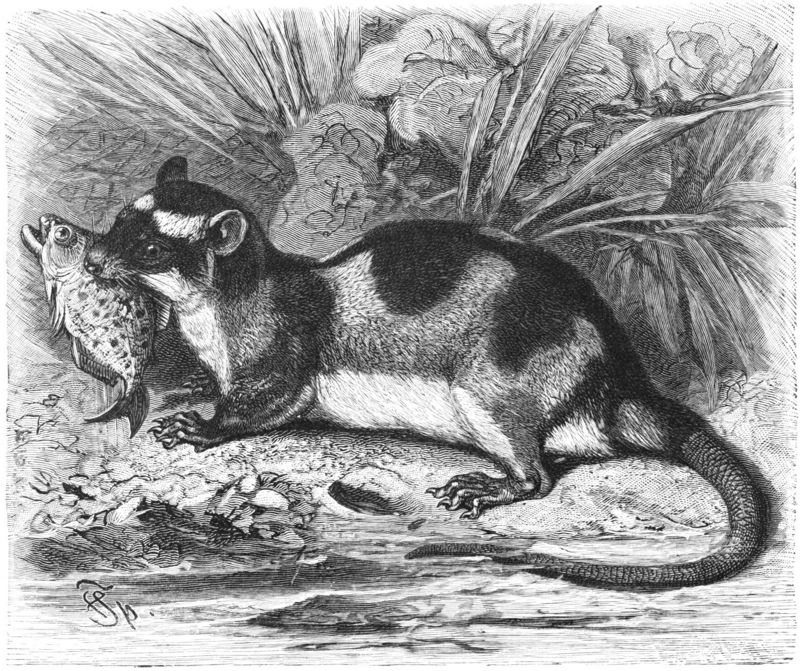|
| 질의: living fossil | 결과: 275번째/375 | |
Water Opossum (Chironectes minimus) - Wiki
| 제목: | Water Opossum (Chironectes minimus) - Wiki
| |

| 해상도: 1580x1326
파일크기: 764165 Bytes
등록시간: 2007:11:23 14:10:01
|
Water Opossum
From Wikipedia, the free encyclopedia
Order: Didelphimorphia
Family: Didelphidae
Subfamily: Didelphinae
[Photo] Water Opossum (Chironectes minimus) drawing. Originator: Friedrich Specht. Source: Brehms Tierleben, Small Edition, 1927.
The Water Opossum (Chironectes minimus), also locally known as the Yapok, is a marsupial of the family Didelphidae. It is the only member of its genus, Chironectes. This creature is found in the freshwater streams and lakes in Mexico, Central and South America to Argentina, and is the only living aquatic marsupial.
The animal lives in bankside burrows, emerging after dusk to swim and search for fish, crustaceans and other aquatic animals, which it eats on the bank.
Origin of the name
The local name for the Water Opossum, "Yapok", probably comes from the name of the Oyapok River in French Guyana.
True opossums are unique to North America alone. The word "opossum" was taken from the native Algonquian word for the animal. Though the Yapok, as well as other marsupials in South America and Australia are called "possums," they are not closely related to the Virginia animal, and only derive their name by a generally similar shape and appearance.
Physical appearance
The Yapok is a small opossum, 27-32.5 cm long, with a 36-40 cm long tail. The fur is in a marbled grey and black pattern while the muzzle, eyestripe, and crown are all black. A light band runs across the forehead anterior to the ears, which are rounded and naked. There are sensory facial bristles in tufts above each eye as well as whiskers. The animal's tail, furred and black at the base, is yellow or white at its end. The hindfeet of the Yapok are webbed, while the forefeet ("hands") are not. The forefeet can be used to feel for and grab prey as the Yapok swims, propelled by its tail and webbed back feet.
Aquatic adaptations
The Water Opossum has several adaptations for its watery lifestyle. It has short, dense fur which is water-repellent. The broad hindfeet are webbed and are used for propulsion through water, moving with alternate strokes. They are symmetrical as well, which distributes force equally along both borders of the webbing; this increases the efficiency of the water opossum's movement through the water. The Yapok's long tail aids its swimming as well.
Being a marsupial and at the same time an aquatic animal, the Water Opossum has evolved a way to protect its young while swimming. A strong ring of muscle makes the pouch (which opens to the rear) watertight, so the young remain dry, even when the mother is totally immersed in water. The male also has a pouch (although not as watertight as the female's), where he places his genitalia before swimming. This is thought to prevent it from becoming tangled in aquatic vegetation and is probably helpful in streamlining the animal as well as it is swimming quickly.
Reproduction
Yapoks mate in December and a litter of 1-5 young is born 2 weeks later in the nest. By 22 days the offspring are beginning to show some fur, and by 40 days or so their eyes are open, their bodies protruding from the mother's pouch. At 48 days of age, the young opossums detach from the nipples but still nurse and sleep with the mother.
Fossil record
The Water Opossum seems to have a history dating as far back as to the Pliocene epoch.
Holocene subfossil fragments of Chironectes have been discovered in S??o Paulo, Brazil. Also, there are fossil specimens from the late Pleistocene-Recent cave deposits in Minas Gerais, Brazil as well as from the late Pliocene in Entre Rios Province, Argentina.
Subspecies
Chironectes minimus argyrodytes
Chironectes minimus langsdorffi
Chironectes minimus minimus
Chironectes minimus panamensis
http://en.wikipedia.org/wiki/Water_Opossum
| The text in this page is based on the copyrighted Wikipedia article shown in above URL. It is used under the GNU Free Documentation License. You may redistribute it, verbatim or modified, providing that you comply with the terms of the GFDL. |
|
^o^
동물그림창고 똑똑전화 누리집
^o^
|
|